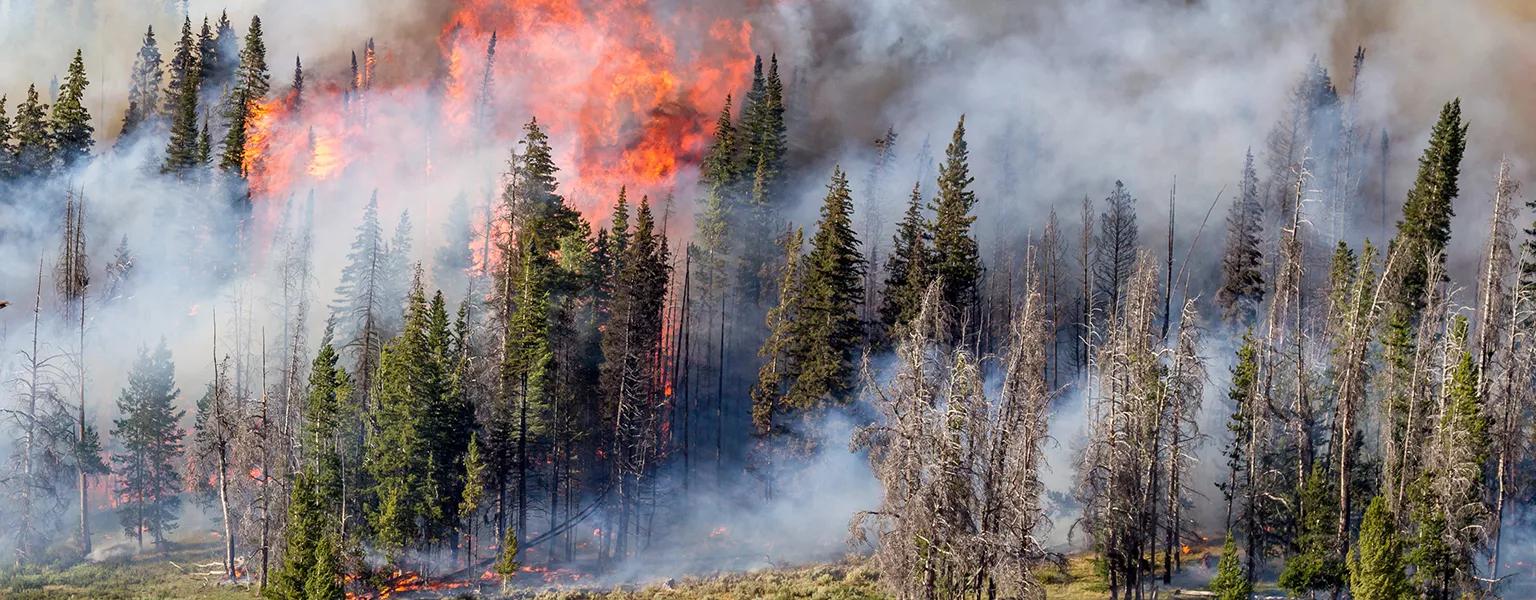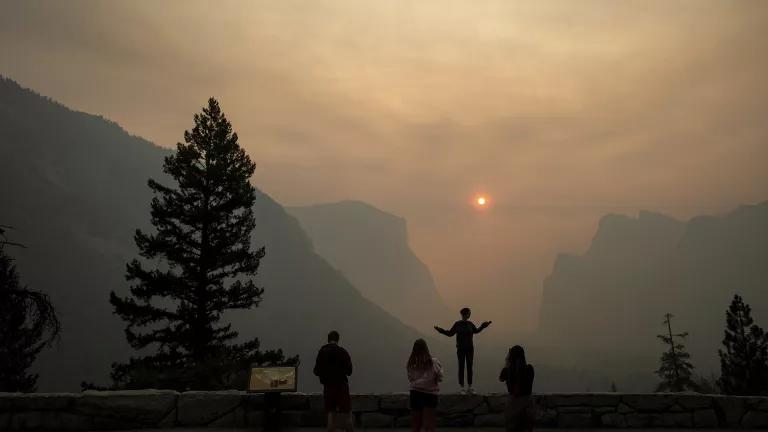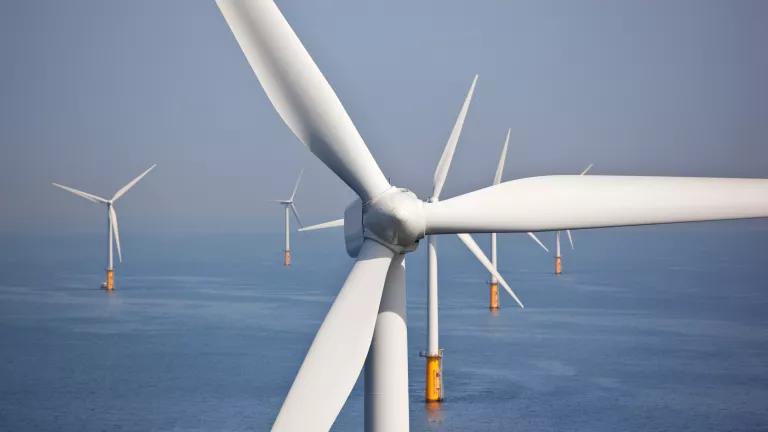
U.S. Army
Overview
Climate change is the major environmental challenge of our time, and we know we must accelerate our efforts to adapt to the impacts that are already unavoidable. We have the technologies and the ingenuity to dramatically lower the emissions that are causing the crisis. A growing number of feasible and effective solutions exist here and now. We must propel them forward, and work toward a future that is more sustainable and just. Toward this end, we work in the United States, China, India, and other countries with communities, allies, and decision makers at every level of government to advance policies that will yield deep cuts to carbon pollution, end our dependence on dangerous fossil fuels, and prioritize the people and ecosystems on the frontlines of our changing climate.
Solutions
Though we cannot prevent climate change outright, we can reduce emissions and impacts with solutions that strengthen the resilience of communities and save lives. Here are our current priorities:
Strengthen climate policy across all levels of government in the United States
We push for crosscutting climate mandates and work with decision makers to enact them. In the Northeast and mid-Atlantic, we’ve helped shape the Regional Greenhouse Gas Initiative, a market-based program to cut carbon pollution from power plants. On the West Coast, we advocated for the California Climate Crisis Act, which codifies the state’s commitment to achieving net-zero carbon emissions by no later than 2045. Our policy solutions emphasize economic outcomes too, including opening up job opportunities and benefiting consumer pocketbooks, as through Illinois’s Climate and Equitable Jobs Act and New York’s Climate Leadership and Community Protection Act. At the federal level, we are working to ensure that the U.S. Infrastructure Investment and Jobs Act advances climate and equity goals, including through support for clean, high-quality, and affordable transportation options.
Promote climate adaptation measures
We’re focused on strategies to help communities and nature adapt to the current conditions and reduce future suffering. Our priorities include boosting public health infrastructure and occupational protections for workers on the frontlines, developing heat action plans, addressing the growing problems of flooding and sea level rise, making cities and communities better prepared for drought, supporting healthy practices on farms that will stabilize our food system, aiding in preparations for people grappling with displacement from climate-driven disasters, and ensuring more timely and equitable distribution of funding for those in harm’s way, such as in flood-prone communities. We also work to promote community-driven solutions to climate adaptation, so that we may avert the ramifications of green gentrification and help people to stay in their homes and access the benefits of sustainable development projects. Finally, we’re working to enhance the resiliency of nature, to ensure the ecosystems we all rely on can adapt to climate change, as through our 30x30 strategy.
Did You Know?
The earth’s average surface temperature has increased faster over the last half century than during any other 50-year period over the past 2,000 years. And atmospheric carbon dioxide levels are higher right now than at any point during the last two million years.
Spur investments in renewables and energy efficiency
In many ways, U.S. states are leading the way on the transition away from fossil fuels, including through the creation of mandates for energy efficiency and clean power generation. We’re helping local climate leaders to accelerate these efforts, while simultaneously partnering with utilities and lawmakers at all levels to expand support for efficiency measures that improve customer savings, health outcomes, and quality of life. We’re also advocating for an overhaul of aging U.S. grid infrastructure—which must include the installation of new transmission lines capable of getting wind and solar power to the cities and communities that need it—plus advancing newer technologies like battery storage and offshore wind. We’re working with the Organisation for Economic Co-operation and Development and Indian government on a financing roadmap for three promising but hard-to-finance sectors: offshore wind, green hydrogen, and energy efficiency in small and medium enterprises. Globally, we engage with civil society partners, multilateral development banks, and the private sector to redirect the flow of international finance away from fossil fuel projects and toward clean energy.
Make homes healthier and more climate friendly
While homes and other buildings account for more than a quarter of all global greenhouse gas emissions, there are myriad solutions within our reach to eliminate this climate-warming pollution. In the United States, we are pushing for initiatives that maximize energy efficiency and phase out space and water heating systems that burn fossil fuels, so that buildings are less reliant on oil, propane, and gas, and instead run on clean technologies such as electric heat pumps. Our advocates also seek to increase affordability and access to these cleaner technologies, especially for low-income households, whose energy bills require them to pay a proportion of their income that is, on average, more than three times higher than what the average household spends. In India, we are collaborating with the government and industry to create and implement Energy Conservation Building Codes in critical states. We also collaborate with local women-led partners across India to ensure that the most vulnerable and rural households have access to clean energy technologies, cool roofs, and economic opportunity.
Clean up the transportation sector
Contributing nearly 29 percent of climate pollution in the United States and 13 percent globally, the transportation sector is one of the fastest-growing emissions sources and a key climate action target. Our U.S. advocates push for stronger performance-based standards for auto manufacturers to ensure that tailpipe emissions decline over time, and for expanding electric vehicle charging infrastructure. We’re also shaping policies that help the United States shift away from diesel trucks and buses that poison the air, such as through California’s Advanced Clean Trucks rule. And we’re helping to direct U.S. investments in public transit, and ensuring decision makers put communities first. We are also developing policy resources to advance electric mobility and charging infrastructure in India and China, together with renewable electricity.
Decarbonize the industrial sector
The industrial sector is responsible for 30 percent of U.S. greenhouse gas emissions and 40 percent globally. Without action, it will become the largest source of climate pollution in the United States within the decade. Most industrial emissions come from the production of a small set of carbon-intensive products, including cement, concrete, steel, and aluminum. We’re pushing for a combination of U.S. state regulations and federal incentives and investments to decarbonize industrial plants, using existing solutions like energy efficiency and electrification and by deploying more advanced technologies like green hydrogen for clean steel manufacturing. We also support smart procurement standards, such as Buy Clean, to help ensure that cleaner producers have a competitive advantage. And we’re working domestically, with the U.S. Environmental Protection Agency (EPA), and internationally, with nations under the U.N. Montreal Protocol, to implement the Kigali Amendment—a critical agreement that phases down hydrofluorocarbons (HFCs), the potent greenhouse gases used in air conditioning, insulating foam, and more.
Shrink the footprint and the power of the fossil fuel industry
We advance reforms at the U.S. Federal Energy Regulatory Commission—which oversees the interstate transmission of gas—that will limit the expansion of unnecessary pipelines, gas, and liquefied natural gas (LNG) export facilities. We complement this supply-side work by collaborating with partners around the world to reduce other countries’ demand for U.S. LNG. We also seek to support Indigenous, marginalized, and BIPOC communities in their fights against the expansion of new fossil infrastructure across state and national borders, and to phase out hazardous dirty energy sites—such as abandoned oil and gas wells—from the places where people live, work, and play. NRDC is simultaneously helping to drive forward legislation that will eliminate antiquated, costly subsidies to the fossil fuel industry, and force fossil fuel companies to pay for the damage they cause.
Catalyze climate finance
We’re working to build a climate-resilient financial system. To do this, we are working in the United States with a wide range of stakeholders to transform the role of public finance institutions at all levels of government to help advance investment in everything from climate-resilient urban infrastructure to clean energy access to sustainable agriculture. We’re also providing U.S. federal banking regulatory agencies with recommendations on how to incorporate climate risk into examinations of individual banks. And to accelerate international climate action, we help to direct financial assistance to developing countries working to reduce their emissions and adapt to the impacts of climate change. Public finance is key, but insufficient for the task at hand—so we are working to catalyze multiple dollars of private funds for every dollar of public capital to help grow a healthier, more durable economy.
Build a more sustainable food and agriculture system
We champion farming practices that limit the use of harmful chemicals, conserve natural resources, build soil health, and make farms more resilient in a changing climate. Indeed, healthy soil is the foundation for agriculture; it also plays a vital role in regulating our climate and allows farmers to mitigate the impacts of increased drought and flooding on their fields. Our advocates are helping to craft provisions in major U.S. agricultural policies that incentivize farmers to adopt techniques that boost their soils’ carbon levels while also protecting habitat for biodiversity and growing healthy food. We’re also advising U.S. lawmakers on ways to invest in more decentralized and diverse food systems infrastructure, break barriers for BIPOC growers to programs that open the door to organic and regenerative farming, and create pathways to serve organic food in schools. And we continue to push for solutions in the United States at the city, state, and federal levels to curb the enormous climate footprint of food waste.
Get cars off city streets
Given that nearly a third of the greenhouse gas emissions in many U.S. cities stem from on-road transportation, we prioritize efforts to help cities offer people safe, efficient alternatives to driving. This includes increasing the speed and reliability of public transit and redesigning streets to prioritize walking and biking. At the same time, we are pushing to reclaim our public space from automobiles by reforming parking requirements that often accompany new developments, taming traffic with congestion pricing, and opposing inequitable highway expansion projects that tear apart our cities, pollute the air, and cut off low-income communities and communities of color from transit hubs and economic centers.
“We know now that solar and wind are already more cost-competitive than fossil fuel power in most places. We know public transit is a safer, more effective, and low-carbon way to move people around. We know protecting forests is not just good for the climate but also for supporting the communities that live in and around the forests. Reducing food waste is not just good for the planet but also good for a person’s pocketbook. Bold climate action is the foundation of a more-efficient, high-growth future.”
Manish Bapna, NRDC president & CEO
Progress
- In 2022, the federal government passed its strongest climate legislation ever. The Inflation Reduction Act contains $369 billion in energy, climate, and community investments to be spent over 10 years, and will enable the United States to hit a 40 percent reduction in greenhouse gas emissions, below 2005 levels, by 2030.
- In 2022, after a six-year delay, the Senate voted to approve U.S. ratification of the Kigali Amendment to the Montreal treaty, signifying that the United States will be a full partner in implementing this powerful ozone and climate protection treaty. The win was backed by environmental and industry groups, as well as lawmakers on both sides of the aisle.
- U.S. states are advancing innovative solutions geared to relieve pressure on the power grid. Rapid demand response programs provide financial incentives for consumers to reduce their electrical consumption during periods when the grid is likely to be under the most stress; such programs have already proven successful in utilities from California to Illinois to New York.
- The pioneering Heat Action Plan put in place in Ahmedabad, India—developed in collaboration with NRDC, the Indian Institute of Public Health, and other partners—has helped the city avoid an estimated 1,100 deaths annually since its implementation in 2013.
- In response to a legal petition filed by NRDC, the Federal Emergency Management Agency is overhauling multiple aspects of the National Flood Insurance Program. The agency is looking at updating floodplain development standards for the first time since the 1970s, making sure the nation’s flood risk maps account for future sea level rise and extreme storms, and making flood mitigation funding more timely and equitable.
- In response to pressure from labor, public interest, and environmental groups, the Occupational Safety and Health Administration initiated a rulemaking for a federal occupational heat safety standard and established a new enforcement program focused on industries with a high risk of heat-related illness and death.
- California has enacted groundbreaking legislation to zero out carbon pollution from cement used in the state, and New York has committed to purchasing low-carbon concrete for state-funded infrastructure projects.
- The Biden administration has signed an executive order on Buy Clean and federal agencies have begun to roll out early procurement standards that ensure major infrastructure projects will rely on low-carbon concrete and steel, among other sustainable materials.
- In California, Colorado, Nevada, New Mexico, and Oregon, $1.8 billion has been approved for utility investments in electric vehicle charging. Importantly, $636 million of that is reserved for underserved and disadvantaged communities.
- New standards proposed by the EPA would significantly cut pollution from oil and gas operations—in particular, the leakage of methane. Specifically, they would reduce atmospheric methane by more than 40 million tons between 2023 and 2025—which, per the EPA, is more than the carbon dioxide that was emitted by all U.S. passenger cars and commercial aircraft in 2019.
- Collectively, the members of the Green Bank Network have invested or committed more than $50 billion in climate projects since the first green bank was founded in 2012. Today, 27 green banks exist in 12 countries, and an additional 20 jurisdictions are exploring some form of green bank solution.
- A new USDA initiative to invest in organic agriculture will help improve resilience and carbon sequestration on farms while also keeping dangerous pesticides out of communities and ecosystems. USDA’s recently announced $300 million Organic Transition Initiative will support a significant expansion of organics in the United States, with a wide range of climate, health, and economic benefits.
More Ways to Make an Impact
Latest News & Resources
Scorching temperatures this summer are further proof that climate action can't wait.
Tell President Biden and Congress to enact game-changing action to confront the climate crisis!

Climate change is heating up the planet...and fast.
View all issues

Climate Change

Equity & Justice

Human Health






























